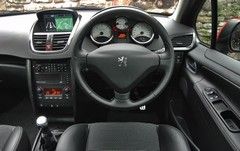Peugeot 207 GT THP 150
High pressure turbo adds tons of torque to this feisty motor. Tom Stewart reports

Peugeot 207 GT THP 150
You’ll know that the original Golf GTi from the 1980s spawned the cult of the hot hatch -- but, of all its copycat rivals, it was Peugeot’s spunky 1.6 and 1.9 205 GTIs which came to really define the genre.
The 206 that followed enjoyed success in WRC guise, but it lacked the involvement and undiluted driving thrills delivered by its 205 predecessors. At the same time ardour for hot hatches cooled during the nineties when buyers seeking change defected to a new generation of affordable roadsters, so the 206 never quite matched the impact or status of the 205 on Real Street.
Now Peugeot is back with the 207 GT -- but can it deliver?
The 207 GT is more properly called the 207 GT THP 150 which provides a vital clue to its character. THP stands for Turbo Haute Pression (High Pressure Turbo) -- and that means 150bhp at 5,800rpm, a thumping 240lb-ft of torque and a Vmax of 131mph.
With all this on tap you could be forgiven for thinking this to be Peugeot’s latest hot hatch but, as there’s a 175bhp 207 GTi version coming next year, the GT will more accurately reside in the warm hatch category.
Gratifying acceleration
Take a GT for a drive though and you’ll more than likely think it’s several degrees hotter than mere ‘warm’. As is often the case, the straightforward 0-62 time, in this case 8.1 seconds, says little about how this car actually performs on the road. The more astute will have already clocked that this motor’s torque figure is substantial, as are the low revs at which this impressive grunt is achieved – just 1,400rpm. And, unusually for a relatively small engine (1598cc) we’re talking petrol here, not diesel.
In short, and assuming you’re in roughly the correct gear (5-speed), a press on the right-side pedal results in instant, enthusiastic and gratifying acceleration. It’s the kind of lag-free grunt that thrusts you out of corners more quickly than expected and, as the needles sweep effortlessly around the dials, it’s all cracking good fun. In fact, according to Peugeot, the 207 GT accelerates from 50-75mph in 5th in 8.2secs, almost two seconds faster than the lighter 206 GTi.
Aiding and abetting this keen athleticism are strong brakes, a responsive electronic power steering system, a surprising absence of torque steer and inside front wheel spin (the latter aided by a non-intrusive, standard ESP system), supportive front seats, grippy tyres and suspension which keeps things nicely under control, even at three figure speeds on bumpy, rural B roads. Given a sweeter, more positive gearchange action, (it’s been imprecise since the 205 and still is), the GT would be close to faultless from the driver’s perspective.
But what about the Mini?
Having driven the new 175bhp Mini Cooper S recently, and the lower spec 120bhp Cooper, both of which use essentially the same PSA/BMW-developed four-cylinder 16v engine, there are some interesting comparisons to be drawn. The pricier Cooper S makes more horsepower than the 207 GT 150 and in a straight drag race the S would cross the finish line first.
However, the 207’s motor is substantially torquier, so in the real world the Pug’s extra 48lb-ft would narrow the gap considerably. As for the ordinary Cooper (no S), it looses out to the 207 GT on power and performance, and its engine feels strained and unwilling when called upon to work hard. Interestingly, and I confess I haven’t yet figured out quite why, this lack of engine refinement isn’t an issue on the turbocharged 207 GT or Cooper S.
Another point in the 207’s favour is that it can comfortably accommodate two fully-grown adults in the rear, something that Minis cannot. The 207 doesn’t have the Minis’ bijou retro chic appearance, which may or may not be a good thing depending on your personal taste, but there’s no doubt that, in common with other recently introduced Peugeot models, the 207’s Achilles heel is its oversized, grinning front air intake.
Grille grilling
This ill-considered move to blindly bestow Peugeots with an aesthetic brand theme at the expense of visual appeal makes no sense to me. I suspect history will record that of the 205, 206 and 207, it was the 207 which was the ugly sister.
But apart from the front grille, the £14,345 207 is an accomplished bit of kit. It’s punchy, fast, great to drive, practical, economical (40.3mpg combined) and reasonably priced and specced. Its interior lacks the feel and perceived quality of the Mini, but it’s the choice your head would make, if not your heart.
More importantly, at least to me as a long-term devotee of the 205 GTi -- I enjoyed a 1.9 for a few years -- the 207 GT more than lives up to expectations. And the forthcoming GTi version should be a real cracker. We hope.
Correction
The torque figure quoted above, which was supplied by Peugeot, is incorrect -- the car has 177lb-ft at 1,400rpm.
Gassing Station | General Gassing | Top of Page | What's New | My Stuff












